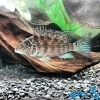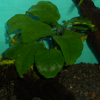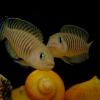
Snail Management And Control
#1

Posted 10 May 2009 - 10:32 PM
If you are one of the many people who would like to cut down the population of snails in your aquarium or attempt to eradicate them then here are a few things you can try.
Where did they come from?
Snails can be introduced a number of ways. The most common snails that are referred to as nuisances are the Malaysian Trumpet Snail (MTS) 'Melanoides tuberculatus' and Ramshorn snails 'Planorbis corneus'. The most common method of introduction is either via plants or substrate. Snails may lay eggs on plants and also in the substrate, often going unnoticed by the aquarist until they reach a distinguishable size and start coming out looking for food, This is often the case when using second hand gravel or adding plants from tanks with snail populations. If you have a live bearing variety of snail (MTS), then you can get it in the bag of fish where the fish were caught in tanks with this snail.
Why are they so prolific?
Snails do not always live up to their bad reputation, it is possible to have a tank with snails and keep their numbers under control. The number one trigger that will cause snails to get out of control is over feeding....this is almost always the case. If an abundance of food is available to the snails then you can rest assure that they will condition themselves up for breeding......excess food also aids the young snails fast growth rate. Live bearing snails such as Malaysian trumpet snails generally hide and bury themselves during the day and are seen most active at night, they often go unnoticed for long periods of times because of this and by the time they have populated your aquarium it's too late. Ramshorns are most active during the day and are an egg layer, they are one of the most common snails to hitch-hike in on plants.
Methods of removal:
Natural: Snails love vegetable matter and algae wafers. By simply placing a small piece of zucchini or an algae wafer in the aquarium you can manually remove them, the food acts as an attractant and brings a vast majority of snails out of hiding......whilst they are having a feast you can net them out of the aquarium and dispose of them correctly (do not expose them to our waterways please) This method is tedious and often is a temporary fix to the problem.
Traps: Snail traps can be either commercially purchased from your LFS or home made. Some are better than others so trial and error works best in this instance.
Most work by placing a piece of food inside the trap and having some form of 'one way entry' system....once they are in and have collected the bait it is very hard for them to escape. This can be left in overnight to catch most inhabitants and generally requires at least 3-4 attempts to get most of the snails... but not all. These traps are best suited to tanks that do not have small fish as the fish like to get into the traps.
Chemical: Snail eliminators come in a liquid form and are added directly to the water column, they contain a lot of copper so care must be taken when dosing the aquarium with them. In most situations they should only be used when you have a Kh reading of at least 4° or 71.6ppm.....use only as directed. All invertebrates and plants are sensitive to copper and so are some species of fish, so read the instructions carefully and use only as a last result or whilst no fish are present in the aquarium. Remove any activated carbon while treating.
If you do not wish to use a chemical, and you do not have any fish or plants in the tank, then you can use large quantities of normal salt.
Biological Control: Some species of fish such as Clown Loachs Chromobotia macracanthus and the Yo-Yo loachBotia almorhae will often hunt down snails and control their numbers. They will never eradicate them completely but will aid in the process. In African cichlid tanks Chilotilapia rhoadesii can also control snail populations. Biological control should only be considered if the fish suits your water parameters and you can accommodate them long term.
Prevention: Prevention is always better than cure! If the food source for the snails is limited, the population will reduce itself to more reasonable numbers. In aquariums when there are a lot of adult snails in the tank, they produce chemicals (pheromones) that reduce the hatching and/or growing of new snails. Take away these adults, and there will be another explosion in numbers until a more sustainable population is reached. In other words, ignore them if you can, and they will dwindle in number in their own time. I personally add snails to my aquariums and have never had a bad 'outbreak'. In the mean time, they are eating various waste products in your tank, including algae and dead leaves (particularity Malaysian trumpet snails) , and recycling them in the gravel for your plants......the aquatic earth worm!
#2

Posted 18 August 2009 - 07:15 PM
#3

Posted 19 August 2009 - 08:46 PM
Cut down your feeding, especially of algae wafers and sinking pellets.
#4

Posted 19 August 2009 - 09:07 PM
Andrea
- mistapredictable likes this
#5

Posted 10 May 2010 - 11:38 AM
#6

Posted 17 May 2010 - 07:48 PM
#7

Posted 18 May 2010 - 08:24 PM
#8

Posted 05 March 2011 - 04:07 PM
#9

Posted 22 March 2011 - 11:16 PM
#10

Posted 05 October 2011 - 05:09 PM
#11

Posted 03 September 2013 - 04:10 PM
I have read that the Dwarf Loach Sidthimunki eats small snails, but should not be used as the only way to get rid of snails.
Im not sure, so do a bit of research if you consider it, but I have read in different places that they eat little snails. Someone else might be able to provide a bit more info on this species.
#12

Posted 03 September 2013 - 04:39 PM
2 year bump????
#13

Posted 03 September 2013 - 10:14 PM
NECRO
#14

Posted 06 September 2013 - 11:07 AM
#15

Posted 06 September 2013 - 11:12 AM
#16

Posted 06 September 2013 - 07:47 PM
I don't mind picking out two compared to 20,000 mate ![]()
#17

Posted 25 July 2014 - 12:06 PM

#18

Posted 25 July 2014 - 04:36 PM
My green terror is a snail assassin!
Tandanus catfish are red hot on snails though I dont have mts I have seen tandanus go nuts on ramshorns.
#19

Posted 27 July 2014 - 08:58 AM
#20

Posted 27 July 2014 - 10:41 AM
0 user(s) are reading this topic
0 members, 0 guests, 0 anonymous users


















